tow PONTIAC GRAND-AM 1995 Service Manual
[x] Cancel search | Manufacturer: PONTIAC, Model Year: 1995, Model line: GRAND-AM, Model: PONTIAC GRAND-AM 1995Pages: 354, PDF Size: 17.81 MB
Page 230 of 354
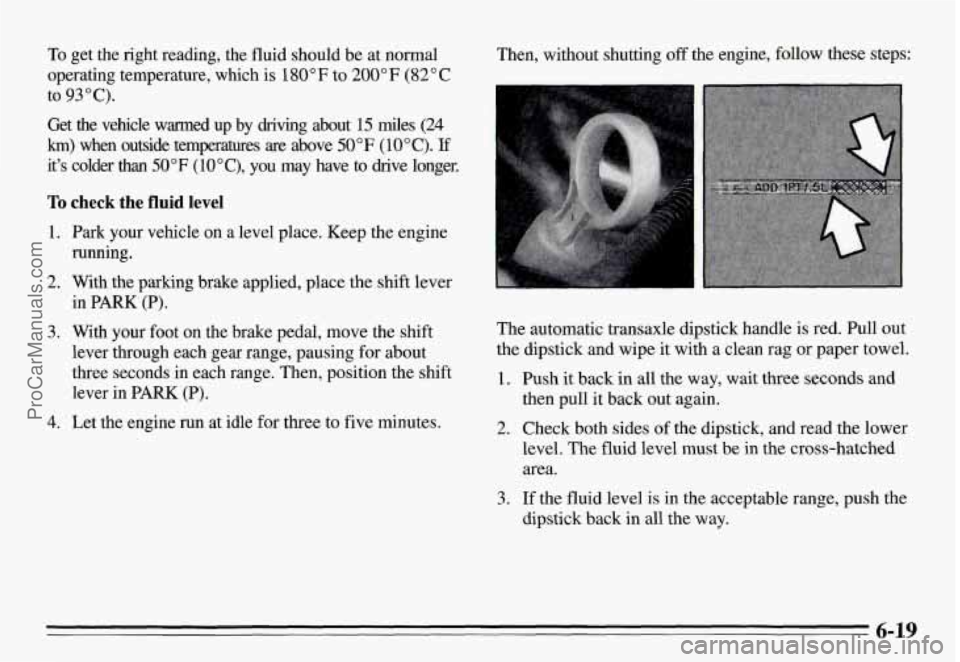
To get the right reading, the fluid should be at normal
operating temperature, which
is 180°F to 200°F (82°C
Get the vehicle warmed up by driving about
15 miles (24
h) when outside temperatures are above 50°F (10°C). If
it's colder than 50 "F ( 10 "C), you may have to drive longer.
to
93°C).
To check the fluid level
1. Park your vehicle on a level place. Keep the engine
running.
in PARK (P).
2. With the parking brake applied, place the shift lever
3. With your foot on the brake pedal, move the shift
lever through each gear range, pausing for about
three seconds in each range. Then, position the shift
lever in PARK
(P).
4. Let the engine run at idle €or three to five minutes. Then, without shutting
off the engine, follow these steps:
The automatic transaxle dipstick handle is red. Pull out
the dipstick and wipe it with a clean rag
or paper towel.
1. Push it back in all the way, wait three seconds and
then pull it back out again.
2. Check both sides of the dipstick, and read the lower
level. The fluid level must be in the cross-hatched
area.
3.
If the fluid level is in the acceptable range, push the
dipstick back in all the way.
6-19
ProCarManuals.com
Page 232 of 354
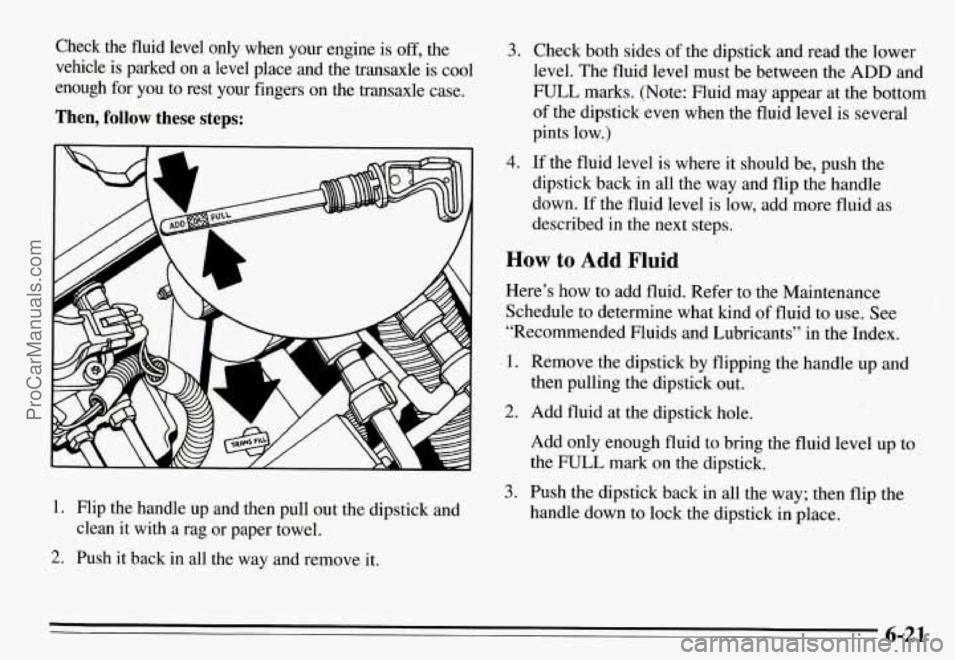
Check the fluid level only when your engine is off, the
vehicle is parked
on a level place and the transaxle is cool
enough
for you to rest your fingers on the transaxle case.
Then, follow these steps:
1. Flip the handle up and then pull out the dipstick and
2. Push it back in all the way and remove it.
clean it with a rag or paper towel.
3. Check both sides of the dipstick and read the lower
level. The fluid level must be between the ADD and
FULL marks. (Note: Fluid may appear at the bottom
of the dipstick even when the fluid level
is several
pints low.)
4. If the fluid level is where it should be, push the
dipstick back in all the way and flip the handle
down. If the fluid level is low, add more fluid as
described in the next steps.
How to Add Fluid
Here’s how to add fluid. Refer to the Maintenance
Schedule to determine what kind
of fluid to use. See
“Recommended Fluids and Lubricants” in the Index.
1. Remove the dipstick by flipping the handle up and
2. Add fluid at the dipstick hole.
then pulling the dipstick out.
Add only enough fluid to bring the fluid level up to
the FULL mark on the dipstick.
handle down to lock the dipstick in place.
3. Push the dipstick back in all the way; then flip the
6-21
ProCarManuals.com
Page 244 of 354
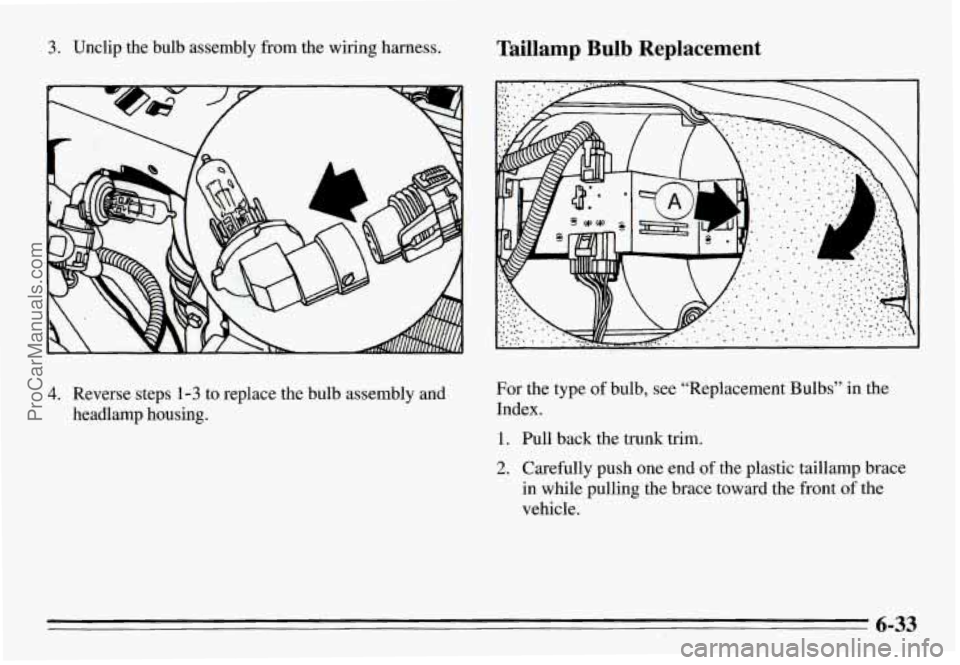
3. Unclip the bulb assembly from the wiring harness.
4. Reverse steps 1-3 to replace the bulb assembly and
headlamp housing.
Taillamp Bulb Replacement
For the type of bulb, see “Replacement Bulbs” in the
Index.
1. Pull back the trunk trim.
2. Carefully push one end of the plastic taillamp brace
in while pulling the brace toward the front of the
vehicle.
6-33
ProCarManuals.com
Page 255 of 354
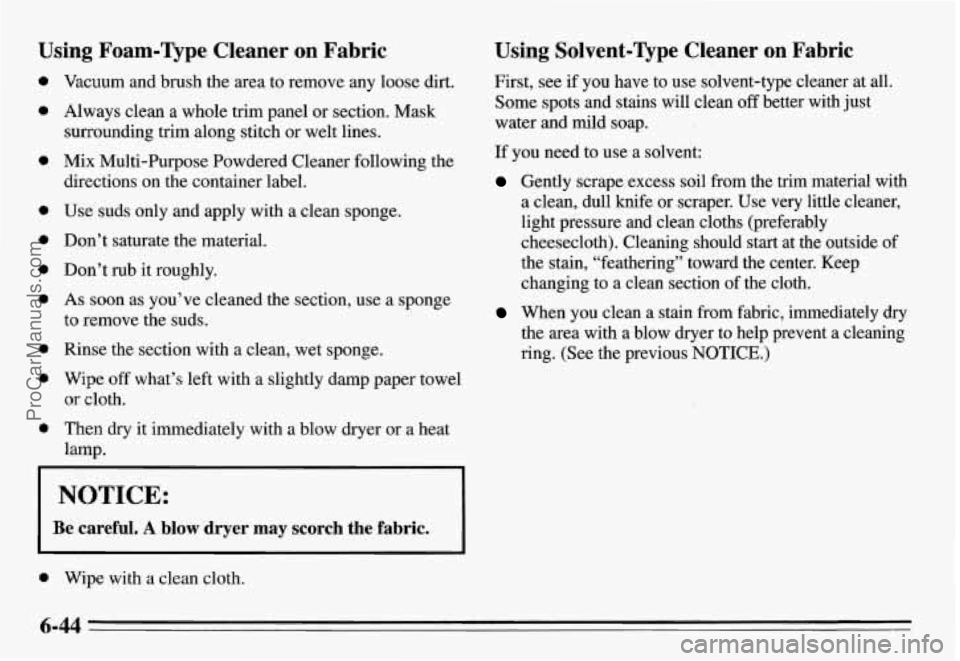
Using Foam-Type Cleaner on Fabric
a
a
a
a
a
a
a
a
a
0
Vacuum and brush the area to remove any loose dirt.
Always clean a whole trim panel or section. Mask
surrounding
trim along stitch or welt lines.
Mix Multi-Purpose Powdered Cleaner following the
directions on the container label.
Use suds only and apply with a clean sponge.
Don’t saturate the material.
Don’t rub it roughly.
As soon as you’ve cleaned the section, use a sponge
to remove the suds.
Rinse the section with a clean, wet sponge.
Wipe
off what’s left with a slightly damp paper towel
or cloth.
Then dry it immediately with a blow dryer or a heat
lamp.
NOTICE:
Be careful. A blow dryer may scorch the fabric. ~~
0 Wipe with
a clean cloth.
Using Solvent-Type Cleaner on Fabric
First, see if you have to use solvent-type cleaner at all.
Some spots and stains will clean
off better with just
water and mild soap.
If you need to use a solvent:
Gently scrape excess soil from the trim material with
a clean, dull knife or scraper. Use very little cleaner,
light pressure and clean cloths (preferably
cheesecloth). Cleaning should start at the outside of
the stain, “feathering” toward the center. Keep
changing to a clean section of the cloth.
When you clean a stain from fabric, immediately dry
the area with a blow dryer to help prevent a cleaning
ring. (See the previous NOTICE.)
6-44
ProCarManuals.com
Page 258 of 354
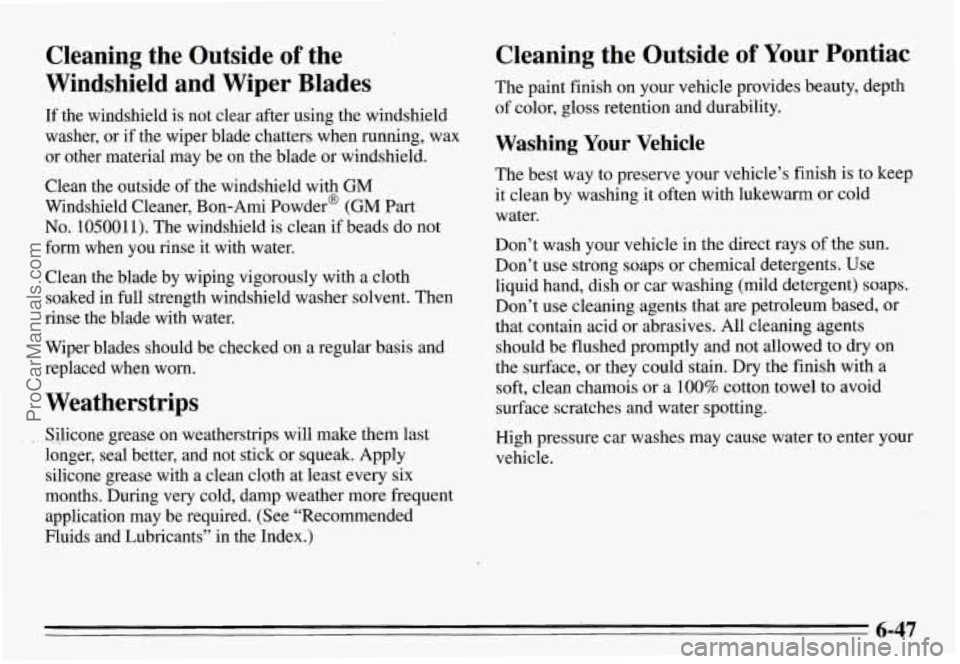
Cleaning the Outside of the
Windshield and Wiper Blades
If the windshield is not clear after using the windshield
washer, or if the wiper blade chatters when running, wax
or other material may be on the blade or windshield.
Clean the outside of the windshield with GM
Windshield Cleaner, Bon-Ami Powder@ (GM Part
No. 105001 1). The windshield is clean if beads do not
form when you rinse it with water.
Clean the blade by wiping vigorously with a cloth
soaked in full strength windshield washer solvent. Then
rinse the blade with water.
Wiper blades should be checked on a regular basis and replaced when worn.
Weatherstrips
. Silicone grease on weatherstrips will make them last
longer, seal better, and not stick or squeak. Apply
silicone grease with a clean cloth at least every six
months. During very cold, damp weather more frequent application may be required. (See “Recommended
Fluids and Lubricants” in the Index.)
Cleaning the Outside of Your Pontiac
The paint finish on your vehicle provides beauty, depth
of color, gloss retention and durability.
Washing Your Vehicle
The best way to preserve your vehicle’s finish is to keep
it clean by washing it often with lukewarm or cold
water.
Don’t wash your vehicle in the direct rays of the sun.
Don’t use strong soaps or chemical detergents. Use
liquid hand, dish or car washing (mild detergent) soaps.
Don’t use cleaning agents that are petroleum based,
or
that contain acid or abrasives. All cleaning agents
should be flushed promptly and not allowed
to dry on
the surface, or they could stain.
Dry the finish with a
soft, clean chamois or a
100% cotton towel to avoid
surface scratches and water spotting.
High pressure car washes may cause water to enter your
vehicle.
6-47
ProCarManuals.com
Page 273 of 354
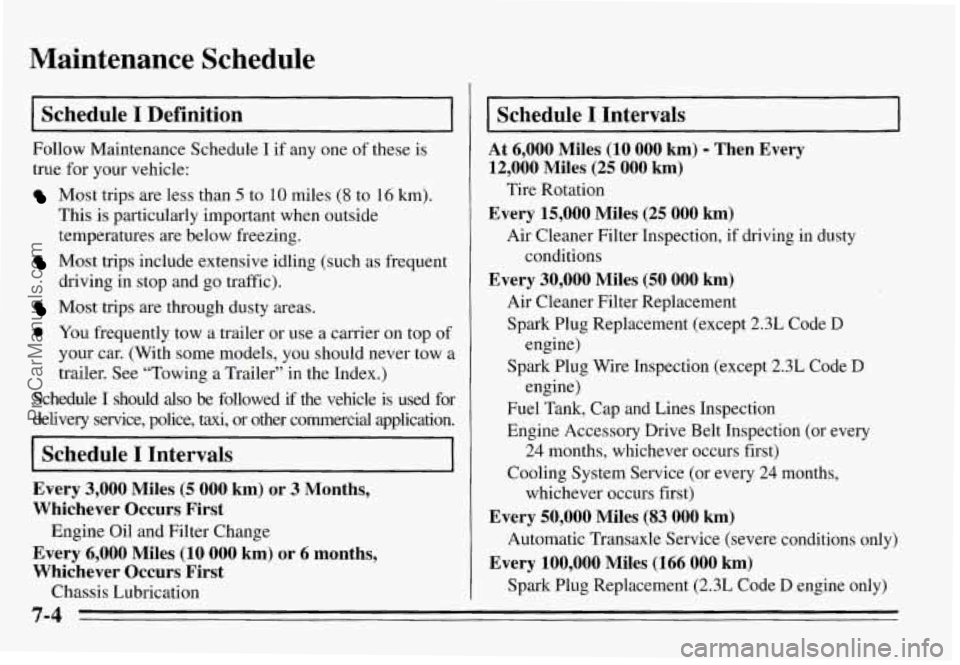
Maintenance Schedule
Schedule I Definition
Follow Maintenance Schedule I if any one of these is
true
for your vehicle:
Most trips are less than 5 to 10 miles (8 to 16 km).
This is particularly important when outside
temperatures are below freezing.
Most trips include extensive idling (such as frequent
driving in stop and go traffic).
Most trips are through dusty areas.
0 You frequently tow a trailer or use a carrier on top of
your car. (With some models, you should never tow a
trailer. See “Towing a Trailer” in the Index.)
S’chedule
I should also be followed if the vehicle is used for
delivery service, police,
taxi, or other commercial application.
Schedule I Intervals
Every 3,000 Miles (5 000 km) or 3 Months,
Whichever Occurs First
Every
6,000 Miles (10 000 km) or 6 months,
Whichever Occurs First
Chassis Lubrication
Engine Oil and Filter Change
Schedule I Intervals
At 6,000 Miles (10 000 km) - Then Every
12,000 Miles
(25 000 km)
Every 15,000 Miles (25
000 km)
Tire Rotation
Air Cleaner Filter Inspection, if driving in dusty
conditions
Every 30,000 Miles (50 000 km)
Air Cleaner Filter Replacement Spark Plug Replacement (except 2.3L Code
D
Spark Plug Wire Inspection (except 2.3L Code D
Fuel Tank, Cap and Lines Inspection
Engine Accessory Drive Belt Inspection (or every 24 months, whichever occurs first)
Cooling System Service (or every 24 months, whichever occurs first)
Every 50,000 Miles (83 000 km)
Every
100,000 Miles (166 000 km)
engine) engine)
Automatic Transaxle Service (severe conditions only)
Spark Plug Replacement (2.3L Code
D engine only)
7-4
ProCarManuals.com
Page 284 of 354
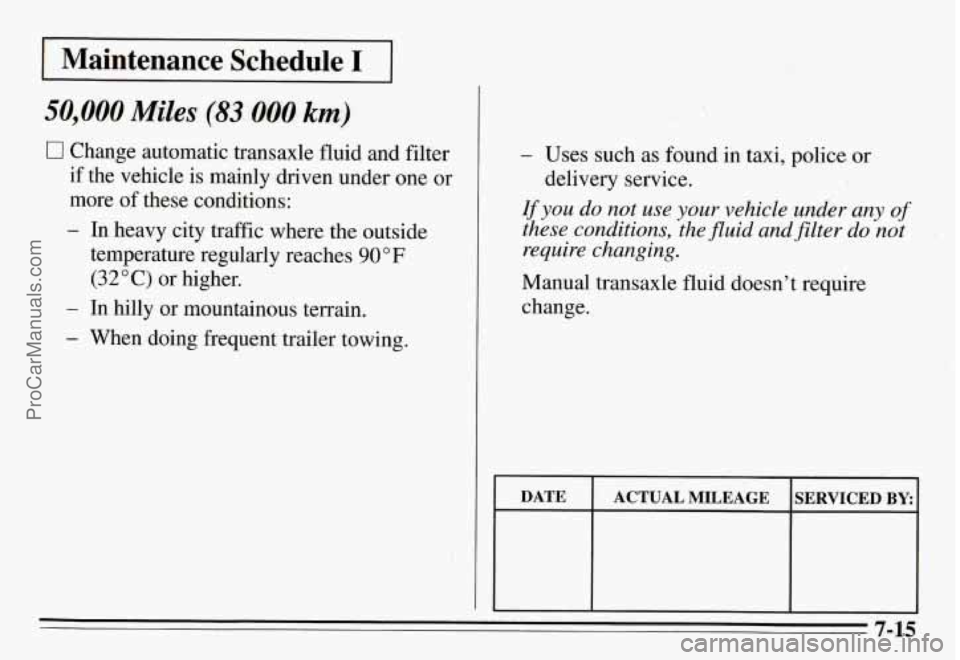
1 Maintenance Schedule I I
50,000 Miles (83 000 km)
Cl Change automatic transaxle fluid and filter
if the vehicle is mainly driven under one
or
more of these conditions:
- In heavy city traffic where the outside
temperature regularly reaches 90 O F
(32 O C) or higher.
- In hilly or mountainous terrain.
- When doing frequent trailer towing.
- Uses such as found in taxi, police or
lfyou do not use your vehicle under any of
these conditions, the fluid and filter do not
require changing.
delivery service.
Manual transaxle fluid doesn’t require
change.
7-15
ProCarManuals.com
Page 295 of 354

Maintenance Schedule I
100,000 Miles (166 000 km)
0 Replace spark plugs (2.3L Code D engine
only).
An Emission Control Service.
0 Change automatic transaxle fluid and filter
if the vehicle is mainly driven under one
or
more of these conditions:
- In heavy city traffic where the outside
temperature regularly reaches
90 O F
(32°C) or higher.
- In hilly or mountainous terrain.
- When doing frequent trailer towing.
- Uses 'such as found in taxi, police or
If you do not use your vehicle under any of
these conditions, the fluid and filter do not
require changing.
delivery service.
Manual transaxle fluid doesn't require
change.
RATE SERVICED BY: ACTUAL MILEAGE
7-26
ProCarManuals.com
Page 300 of 354
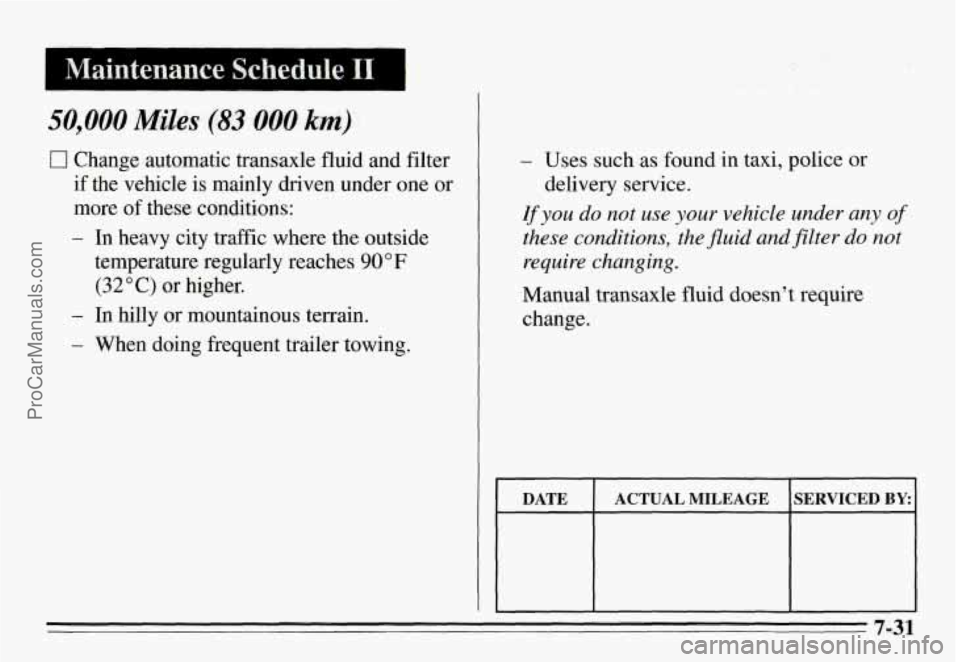
50,000 Miles (83 000 km)
U Change automatic transaxle fluid and filter
if the vehicle is mainly driven under one or
more of these conditions:
- In heavy city traffic where the outside
temperature regularly reaches
90 OF
(32 O C) or higher.
- In hilly or mountainous terrain.
- When doing frequent trailer towing.
- Uses such as found in taxi, police or
If you do not use your vehicle under any of
these conditions, the fluid and filter do not
require changing.
Manual transaxle fluid doesn’t require
change.
delivery service.
DATE ACTUAL MILEAGE SER171CED BY
7-31
ProCarManuals.com
Page 306 of 354

1 Maintenance Schedule I1
100,000 Miles (1 66 000 km)
0 Replace spark plugs (2.3L Code D engine
only).
An Emission. Control Service.
Change automatic transaxle fluid and filter
if the vehicle is mainly driven under one or
more of these conditions:
- In heavy city traffic where the outside
temperature regularly reaches 90 OF
(32 * C) or higher.
- In hilly or mountainous terrain.
- When doing frequent trailer towing.
- Uses such as found in taxi, police or
If you do not use your vehicle under any of
these conditions, the fluid and filter do not
require changing.
Manual transaxle fluid doesn’t require
change.
delivery service.
DATE SERVICED BY. ACTUAL MILEAGE
b
7-37
ProCarManuals.com